Walnuts are not only a delicious delicacy, but also a very useful product that contains a huge amount of vitamins and trace elements necessary for the human body. Walnut tree is a long-liver, so you can safely land it on your new plot.
Thus, you acquire this family tree, which will delight with your delicious and healthy fruits several generations of your family. True, walnut lives on average 200-300 years old and every year it makes it happy with a richer and healing crop of fruits. It is now difficult to find a garden in which walnuts would not have met. However, to obtain a full-fledged tree, you need to know several important moments of how to grow walnut on your own.
In this article, consider the features and description of walnut, as well as we present the characteristics of popular varieties of this culture. We note important nuances of growing walnut in their plot.
Features and description of walnut
Walnut is a deciduous tall tree that belongs to a large walnut family. Many lovers of this delicacy never even imagined how walnut grows. This is usual, just very high, wood with gradually maturing green fruits, which are cracking after ripening and show their core - walnut. This type of walnut can boast a very long and confusing history. There are still disputes about the natural homeland of walnut. Some scientists are prone to the fact that for the first time this nut appeared in Iran, but there is a lot of guess that the natural habitat of walnut can be the territory of China, India or Japan. To date, in nature, a tree with such useful walnut is found in the Transcaucasus, in North China, on Tian-Shan, in Northern India, Greece, Malaya Asia, and even in Norway. However, the largest natural landings of walnut boasts Kyrgyzstan - a real pantry valuable royal walnut.
For the first time about Walnut, Pliny wrote in ancient manuscripts dated 7-5 centuries BC. It is indicated that the ancient Greeks brought the nuts from the gardens of King Persia during one trip. Later, this plant moved to the territory of ancient Rome, and from there all sorts of merchants spread the healing walnut in Europe. On the territory of Russia. Ukraine walnut got from Moldova and first walked the name of the Volosch walnut. You can recall a few more names of Walnut: this is a royal walnut, a Greek walnut.
This is a rather thermal-loving plant, which is growing in nature in southern territories. It can often be found on mountain slopes, gorges, along the banks of the rivers. It grows mainly by singly or small groups, less often there are walnuts of walnut.
Walnut Description:
- Before dealing with how to plant a walnut in its plot, it is necessary to understand its morphological features and conditions of cultivation.
- This is a rather large and powerful leaf fall tree, which in height can reach 25-30 m under favorable cultivation conditions.
- Walnut has a very branched and powerful root system, which in diameter can be approximately 15-20 m.
- The tree boasts a branched and spreaded crown, which is formed by a large number of branches leaving at right angles.
- The trunk of a walnut tree in girth can reach 3-7 m, covered with gray-tight fractured bark.
- The branches of the tree are thickly hung with complex dark green leaves with clearly distinguishable streaks. Walnut leaves are unpacturous, the next, consist of 6-9 small oblong leaves, whose length can be approximately 7 cm.
- The leaves have a specific smell, it is used to produce a dye for textiles.
- At one time with the leaves on Walnut, small, oblong flowers are blooming.
- Flowers on the tree of two floors at once: male and female. Male bloom in the sinuses of the leaves, and women on the tops of annual shoots.
- Blossom starts in May and lasts about 2 weeks. Walnut during the flowering period is a very beautiful sight. The mighty tree is completely covered with green foliage and salad long earrings-flowers.
- After a bunch, fruits appear, which are false stubbles with rather thick peel. Inside the fire is one seed. This is the fruit of walnut, such loved by millions of people.
- The weight of one fetal walnut can be approximately 8-15 grams, it all depends on the specific grade and place of growth.
- He is a long-liver, may increase 300-500 years to grow, in the wild to 1000 years.
- It has excellent ability to grow and restore the shoots of shoots after circumcision and frostbite.
- Frost resistance is not very high, can withstand up to 25-27 degrees.
- The Walnut tree refers to valuable rocks and is used to make expensive designer furniture.
Choose a grade of walnut for your garden
To date, the breeders are simply derived a huge amount of walnut varieties that have excellent resistance to strong frost, diseases and pests, bring large crops of large fruits. Russian scientists in recent years are engaged in the removal of cold-resistant varieties, which can withstand strong frosts of the middle strip of Russia and give a rich harvest. Consider the characteristics of the most popular grades of walnut.
- The grade of the walnut "Skino". This variety brought Moldovan breeders. It is a yield variety with sufficiently highly resistant frost. Skinsky walnut can boast of large fruits whose weight on average is 12 grams.
- Grade Coderene. It is also a variety of Moldovan selection, which is famous for its cold resistance and good fruiting. The trees of this walnut are rarely affected by pests and diseases. The fruits are large, easily removed from the shell.
- The grade of walnut "Bukovinsky 1,2". Late grades of walnut, which were brought by Ukrainian breeders. Different with high yields. The fruit is covered with a thin and easily splitting shell.
- Variety "Carpathian". Late variety derived in Ukraine, which is distinguished by stability to drone spot. This grade of walnut is considered high-yielding, with a permanent harvest. The fruits are covered with a thin shell, which is easily separated.
- Sort "Transnistrian". Also a Ukrainian grade, which is distinguished by resistance to some diseases and strong frost. Mid-line variety with large fruits whose weight is 11-13 grams. Sheath is thin, but very dense.
- Grade "Black California Walnut". Very unusual variety of American selection. It has a good harvest of large fruits covered with a thick black shell with plenty of cracks on it.
- Grade walnut "Santa Rosa". This is a variety of American selection, which was bred in California. Differs in high yield. There are two varieties: early and medieval. The wood ripen the medium-sized fruits that are covered with white leather. The fruits themselves are also white.
- The grade of walnut "Ideal". This variety is considered the most popular and has a large number of advantages that should be considered when choosing a variety you need. The variety ideal is a variety of Russian breeding and safely be called the most harvest of all the walnut varieties known today. This is explained simply: the nut gives a crop twice. This variety is also highly resistant to frozen, so it is great for the middle strip of Russia. It can boast of large fruits whose weight on average is 13-15 grams. At a high level and taste quality of fruits. A feature of this variety of walnut is that the trees are multiplied only by a seed way.
- Grade "Giant". Very resistant to frosts grade, which is characterized by a good crop of delicious fruits. It is the trees of this variety that can be successfully grown throughout Russia.
- Walnut variety "Dessert". Early grade of walnut, the fruits of which are characterized by a sweet taste. The tree itself is rather low, but with a very spreaded crown. This variety is ideal for landing in the southern regions. The weight of one fetus is approximately 15 grams.
- Grace "elegant." This variety is characterized by good frost resistance, drought resistance and immunity to diseases and pests. The middle height tree can grow 4-5 meters.
Walnut reproduction: the most common ways
If you wondered how to plant a walnut on your site, it is necessary to familiarize yourself with all possible methods of reproduction that are suitable for this culture. For self-breeding of walnut, two ways are suitable: seed reproduction and reproduction by vaccination.
Seed breeding of walnut
- This method of reproduction is sufficiently long and requires a lot of effort and time. It should be borne in mind that young plants grown from walnut seeds inherit only 80% of maternal signs. The exception is the "ideal" grade, which multiplies only by seeds.
- First of all, it is necessary to remember that the seeds should be collected from healthy and strong adult trees. This can be done on your own site, if you grow a walnut tree. Or, as an option, you can ask one fruit of walnut from your familiar gardeners.
- You have to choose very ripe fruits that are well separated from the walls. This can be determined by pericarda - a special layer around the kernel. If she crackled, then the nut matured.
- It must be removed and dried in a bright sun around the week.
- Then our seed nuts need to be transferred to the room where they are dried at a temperature of 20 degrees.
- You can plant nuts directly in the fall, and you can wait until spring and fall after thawing the soil.
- When planting seeds of walnut in spring, they must be subjected to the process of stratification. The period of stratification depends on the varieties of nuts. If you can trudge the fatroin nuts, they must be stratified within 90-100 days, thin-walled nuts - approximately 30-45 days.
- Stretch nuts are necessary at a temperature of 0-7 degrees.
- After this process, the seeds must be placed in wet sand. To do this, fill the container with clean sand, moisturize it and warm up to a temperature of 15-18 degrees. Next, place the seeds of walnut and keep it until they proceed.
- You can plant seeds of walnut in a greenhouse, while you need to strictly observe the distance between them. Usually between seeds should be 10-15 cm, and between the rows of 50 cm.
- Before boarding open ground, make sure that the soil warms up more than 10 degrees.
- Nuts of different magnitudes are plunged in different ways. Smaller - 9 cm, larger - 11 cm.
- With this method, approximately 70-80% of seeds, the first seedlings of which appear in approximately in April.
- If you planted seedlings in a greenhouse, it will take about 1 year for growing a flow, and for a full-fledged sapling - 2 years. In the open soil, this process stretches by about twice.
Glowing walnut brefing
- Reproduction using vaccination is the main one that can be used to breed this culture.
- This method is carried out by the method of eyepling.
- The Walnut tree has very large kidneys, and this must be considered when cutting a shield from a given.
- The cure should be in a length of 35 cm and in a thickness of 7 mm.
- At the end of May, the ring of the bark with the kidney is cut off with a sharp eyepulitory knife.
- Further, on the selected, it is necessary to make two nurses and remove the cortex strip. After that, we applied the shield of the lead to the long, where the bark is cut.
- The place where the shield was attached is wrapped with a tape, leaving free eyes.
- After 3 weeks, the isolate can be removed, since the connection site has already grown.
- In our latitudes it is necessary to remember that the presence in the first year may die from frost. Therefore, it is recommended to dig up with a lead in the fall and store it in the basement to spring.
- Walnut seedlings grown in this way, fully inherit maternal signs.
Preparatory stages before landing walnut
It's not so difficult to grow a walnut on its plot, the main thing is to carry out the right and thorough preparatory work, from which the further growth and development of the tree will depend on it. It is important to purchase high-quality, and most importantly healthy, walnut seedlings and find the place with fertile soil optimal for its growth.
Stage 1. Selection of grade and walnut seedlings
- The choice of a walnut variety is an important step to obtain a tree that gives large yields of healthy nuts.
- Acquire a variety, focusing on your climatic belt. If you live in the cooler regions of the middle strip of Russia, it is better to give preference to the varieties of Russian selection and Ukrainian. Excellent sorts of variety ideal, Giant. For more southern regions, you can purchase walnuts of American and Moldovan selection.
- Ideally purchase several options and instill them yourself on your site. So you can choose the most suitable walnut variety.
- You can purchase walnut seedlings in specialized nurseries, agrofirms and garden centers of your region, which are professionally engaged in breeding plants. Thus, you buy young trees, fully adapted to the climatic conditions of your region.
- Buy walnut seedlings are needed in early spring before landing with a closed or open root system.
- Before buying with special care, inspect the planting material. There should be no dry or fallen roots, the soil in the container should be clean and wet. The plant itself should not have visible damage and signs of disease.
Stage 2. Choosing a place to land a walnut
- It is also important to choose the right place to land the walnut, because it will grow on it this tree will be several hundred years.
- The Walnut tree does not carry a close space, so highlight a large piece of land for it, where other large trees do not grow nearby.
- Walnut seedlings need to be planted at open solar sites, where the rays of sunlight will constantly fall on them. This is necessary for the ripening of valuable fruits.
- You can land walnut near the house or another building, where the tree will not interfere with other plants shadow and its branched roots.
- If you sit down several walnut trees, be sure to follow the minimum dance between them. On average, it should be 7-8 meters.
- You can plant a walnut on small slopes and on the hills, however, avoid lowland and very wetlands, as the tree does not take out stagnation of water from the roots.
Stage 3. Choice and preparation of soil for walnut
- Walnut prefers to grow on light and loose soils.
- The earth in the selected place should be fertile and well to pass the air and moisture, drainage is an important condition for the full growth of the tree.
- The ideal soil is moderately wet carbonate loam with groundwater in the level of 2.5 meters, not higher.
- Before boarding, be thoroughly unpacked the soil and add humus to it. After that, shove the surface and scatter, give the soil a little settlement.
Walnut landing technology in open ground
- The walnut landing is carried out in the spring, but in more southern regions there is an autumn planting of culture.
- First of all, the selected location you need to dig up the landing wells, the size of which should be 60 cm in diameter and 40 cm in depth. It is done in the fall. If you sit down several seedlings nearby, observe the distance between them at least 5 meters. The duck up the top layer of the soil set aside - he will need it.
- In the soil, be sure to add 2 kg of superphosphate, 800 grams of potassium chloride, 800 grams of dolomite flour, 1.5 kg of wood ash and peat. All thoroughly mix and pour into the landing holes, fill with water and leave it until spring.
- In the spring before landing, get the soil from the holes and take in the center of the peg, around which you need to pour a small slide from the soil.
- Next, place a walnut seedlock in the pit so that its root neck is 3 cm below the soil surface.
- Put the sapling seedling and carefully compact the soil around it with your hands.
- Understand the seedling and tear it to the peg. After watering the root neck will be closed with a surface.
- After planting, be sure to inspire the rolling circle peat or sawdust.
Walnut Growing Agrotechnology: Secrets and Nuances of Care
Caring for walnut is not much different from the care of other fruit trees in the garden, but this process all has some distinctive features that should be considered.
Watering walnut
In the spring and summer, the Walnut tree is in dire need of regular and abundant irrigation. It is necessary to do this once a month, and at the most dry time the amount of irrigation should grow to 2-3 times a month. With that, each square meter should have 30 liters of water. To prevent excessive evaporation of moisture and drying the roots, it is recommended to periodically be a mulch in the form of peat or wood sawdust. It is not necessary to loose after irrigations, since walnut does not like it.
Falker of walnut
Up to 3 years, to feed the walnut should not be - he has enough nutrients that were made during the landing. After that, it is necessary to fertilize regularly. In the spring, the tree can be picked up with nitrogen fertilizers, the autumn can be made phosphate and potash fertilizers. It is necessary to make fertilizers in the form of a solution and infusions, since this culture does not endure the soil.
Pruning walnut
An important stage of the care of walnut - pruning. In the spring, the sanitary and molding trimming of walnut is always carried out, and in the fall only sanitary. Forming trimming is very important for this culture, since defects appear on branches without it and it affects fruiting. During sanitary trim, remove all damaged, dry and sick branches. The first trimming is carried out when the tree reaches a height of 150 cm. To do this, use a sharp secateur. It is necessary to leave no more than 10 skeletal branches in the crown, all shoots are shortened by 20 cm, and the strab is constantly thinned. Forming the skeleton of the crown, in the future you will need only to cut it out, removing thick and interfering branches.
Walnut fruit collection
Collect only ripe fruits. It is possible to determine the ripeness by the ocoplodnik: if it crackled, then the fruits can be disappeared. After that, they are placed on a week in the basement, so they will be easier to clean. For cleaning nuts, do not forget to wear gloves, as the octoplate contains a lot of iodine. Collected nuts need to rinse in water and leave to dry out the sun.
Fighting diseases and pests of walnut
Walnut Diseases:
- Bacteriosis. Manifested by black spots on the leaves, after which they fall. Before the start of flowering, it is necessary to process the tree with copper vigorous or burglar liquid, and the autumn needs to remove all the leaves.
- Brown spotty. It is manifested by brown spots on the leaves, from which the foliage is completely popped. Its and fruits are infected, which also fall. If diseases only appeared, be sure to remove all damaged leaves. With a large-scale disease, use vecta type preparations.
- Root cancer. This disease amazes the root system of the plant. The speaker penetrates through cracks in the core and forms the growths on it, which must be opened and handled with a solution of caustic soda.
Pests:
- American white butterfly. When this pest is detected, it is necessary to burn the place of the caterpillage of the caterpillars and treat the plant with lepyocydom.
- Nut tick. Acaricides are used to combat this pest.
- Aphid. Under the defeat, the aphids must immediately begin processing with strong preparations, for example, accutelic.
Photo of walnut
Walnut is a storehouse of useful vitamins and elements. If you have your own plot and you like nuts, you should not constantly buy them in the store at a fairly high cost, you can buy a seedling and put it near the house. So you will get good delicacy practically without leaving home.

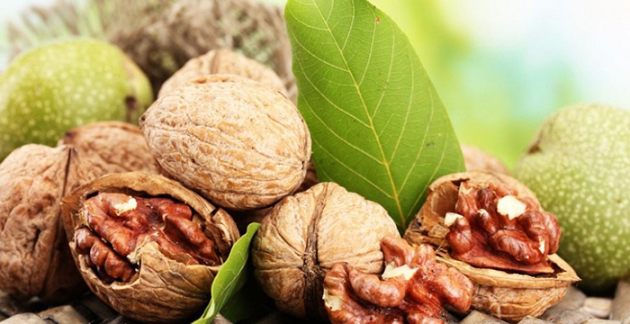
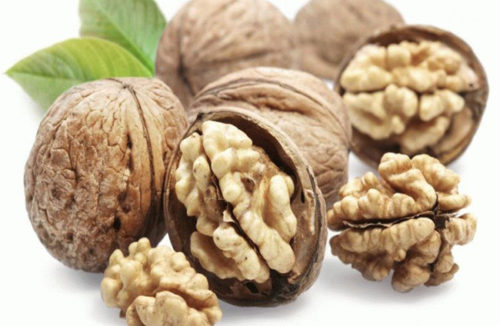
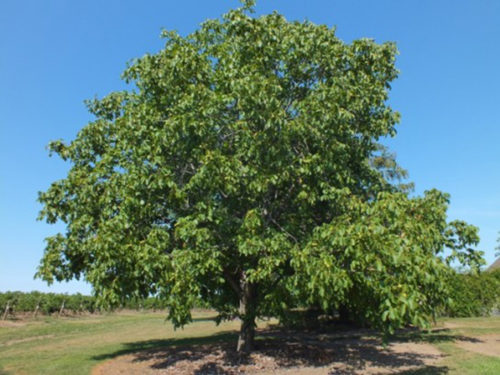
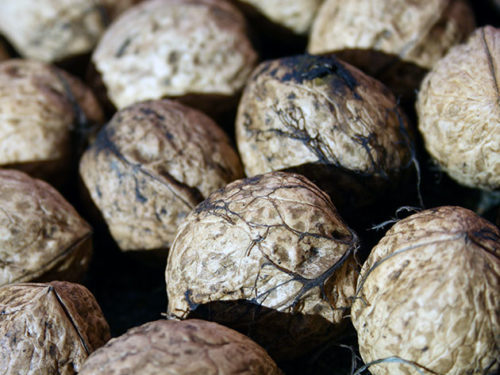
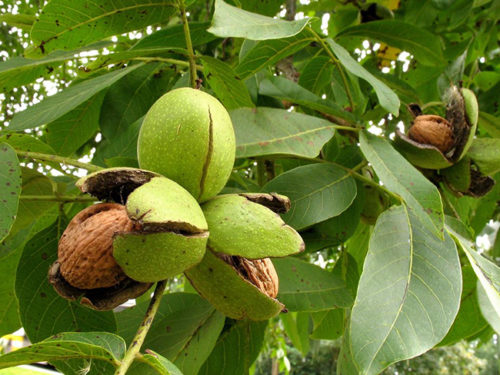
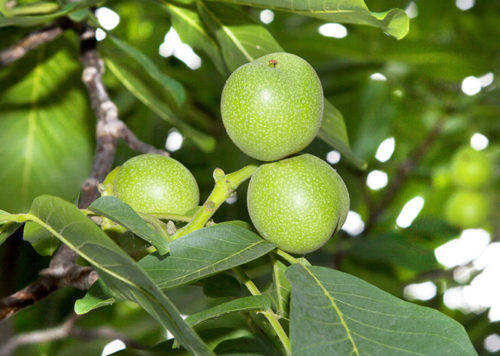
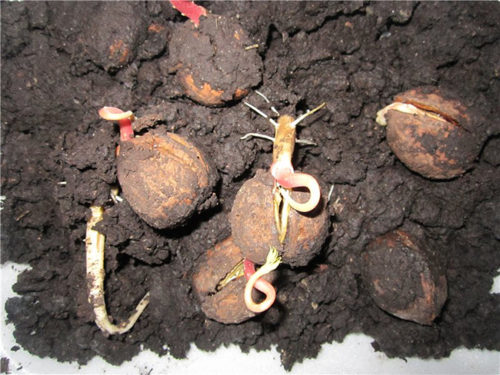
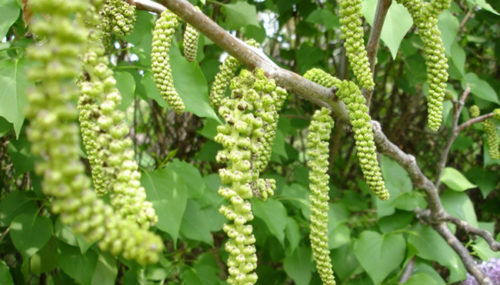
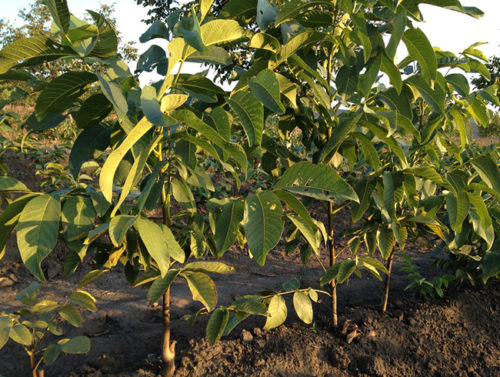

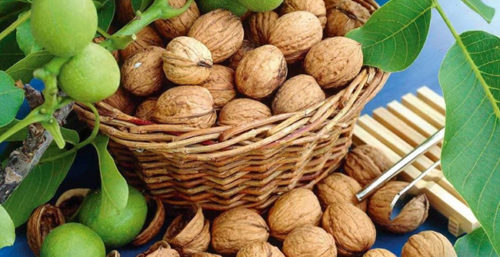
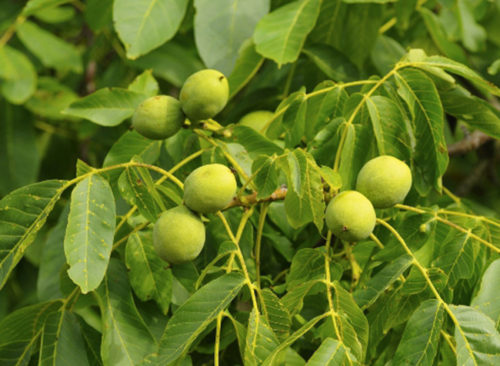
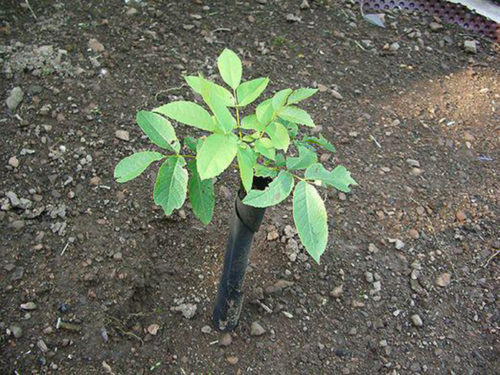
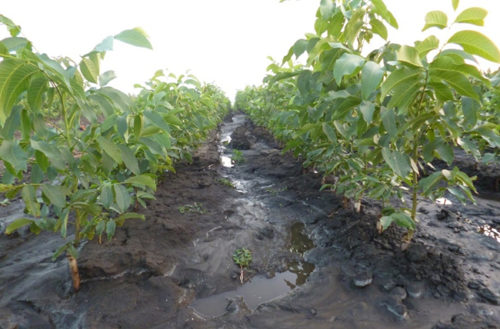
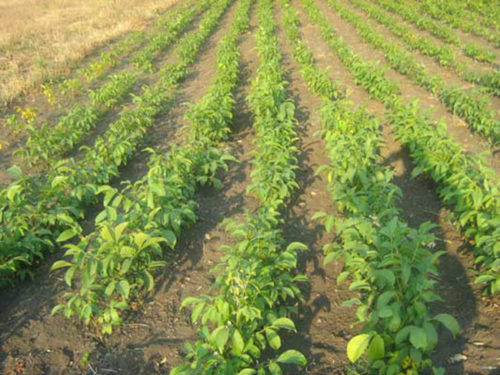












 Start a discussion ...
Start a discussion ...